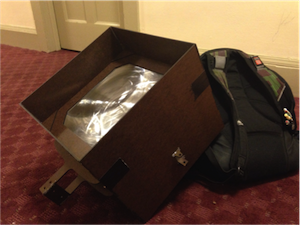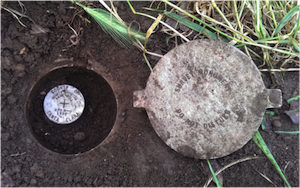OpComms System III
System III is the third design iteration of the OpComms optical link. It consists of a laser transmitter and custom Fresnel lens receiver, interfacing with a commercial photodetector. This system has successfully transmitted data over a distance of 10km, from Skyline Boulevard to W6YX.
Fresnel Lens
The System III receiver uses a ~12" x 12" Frensel lens [1], sold as a replacement part for overhead projectors. A Frensel lens employs complex internal geometries to mimic the optical properties of a conventional convex lens, while maintaining a thin plate shape. The effect of this is that a large lens can be made cheaply and does not occupy as much space as a traditional lens of similar aperture (i.e. the size of the inlet, which limits the amount of light a lens will allow to pass through). The Optical Comms team switched to a Fresnel lens receiver after demonstrating that the larger aperture allowed by the lens gave better light output to the photodetector over the conventional telescopes that had previously been used. Telescopes were cost limited to about a 6 inch aperture for the group, while very large Fresnel lenses could be easily acquired with some creative Craiglist searching (the largest of these came in the form of an old rear-projection television monitor).
The Fresnel receiver system underwent one major design revision, moving from the original foamcore construction, which proved structurally inadequate, to a more robust high-density fiberboard design. The latest version includes fine focus capabilities, simplified mechanics, and a better solution for attachment to the motorized altitude/azimuth mounts, which are necessary for long-distance tests.
MATLAB alignment script
The group has developed a coarse alignment strategy based on the acquisition of a heading from known reference points, which has been implemented in a MATLAB Graphical User Interface. In order to get a fix on alignment, the software requires GPS coordinates for its present location, the target, and two reference points, as well as the altitude and azimuth shift required to traverse from one reference point to the other. From this, the script can derive the effective “tilt” of the mount from horizontal, and the altitude and azimuth adjustments needed to reach the target point. This computation requires a transformation from spherical coordinates about the Earth’s center (i.e. GPS) to spherical coordinates about the current point of reference.
In experimental measurements, this alignment strategy was accurate to about 10m from the target at a distance of 10km, which includes error introduced by mechanical precision, the software interface, and human inaccuracies in alignment with reference points. The group has worked to mitigate human error by first bore sighting [2] the transmitting laser with the small telescope onto which it is mounted, then using the optics of the telescope to align with reference points, to ensure an accurate heading. This method is limited by the ability of a human operator to correctly identify and center the reference points. For the 10km test, conducted between an observation point on Skyline Drive and W6YX, the Amateur Radio Station in the Stanford Dish, the transmit group has used local airports as reference points because they are easily identifiable by the linear patterns of runway lights and the regular flash of the control tower lights.
Alignment telescope laser system
In System III, the transmitting laser is mounted to a small Celestron Nexstar telescope, which allows for fine adjustment of the laser system to collineate it with the telescope barrel. The telescope is mounted to a motorized altitude/azimuth mount, in order to make fine alignment adjustments. The optical properties of the telescope proved exceedingly useful when aligning at long distances, because the laser heading could be visually confirmed by looking through the eyepiece of the telescope. In some cases, this became vital because the target points were locations where laser transmission was unacceptable, such as airports.
A secondary 5mW green (532 nm) laser was also purchased, with the intent to more properly match the optical characteristics of the receiving photodetector. This green laser was used in the final, successful 10km test, due to its perceived* ability to cut through the dense fog that lay in the valley between the transmit and receive locations.
*note: this has not yet been quantitatively verified
GPS Verification
In order to investigate the accuracy of GPS measurements, which can potentially introduce another source of error, the group set out to locate several Geodetic Survey Markers [3] near the usual 10km test sites. These marks indicate very precisely triangulated locations determined by surveyors for the US Geodetic Survey. The OpComms team was able to locate mark AA1874 [4], in the parking lot of the Skyline Boulevard test site, as well as nearby HT3252 [5]. By finding these marks, the group was able to confirm the accuracy of some of the GPS coordinates assumed by the MATLAB script. The group also purchased several mid-range quality GPS hand units to verify measurements, and found that in-field measurements were accurate to 4 decimal places in latitude and longitude, but were accurate to only 10’s of meters in altitude, due to the nature of satellite triangulation.

